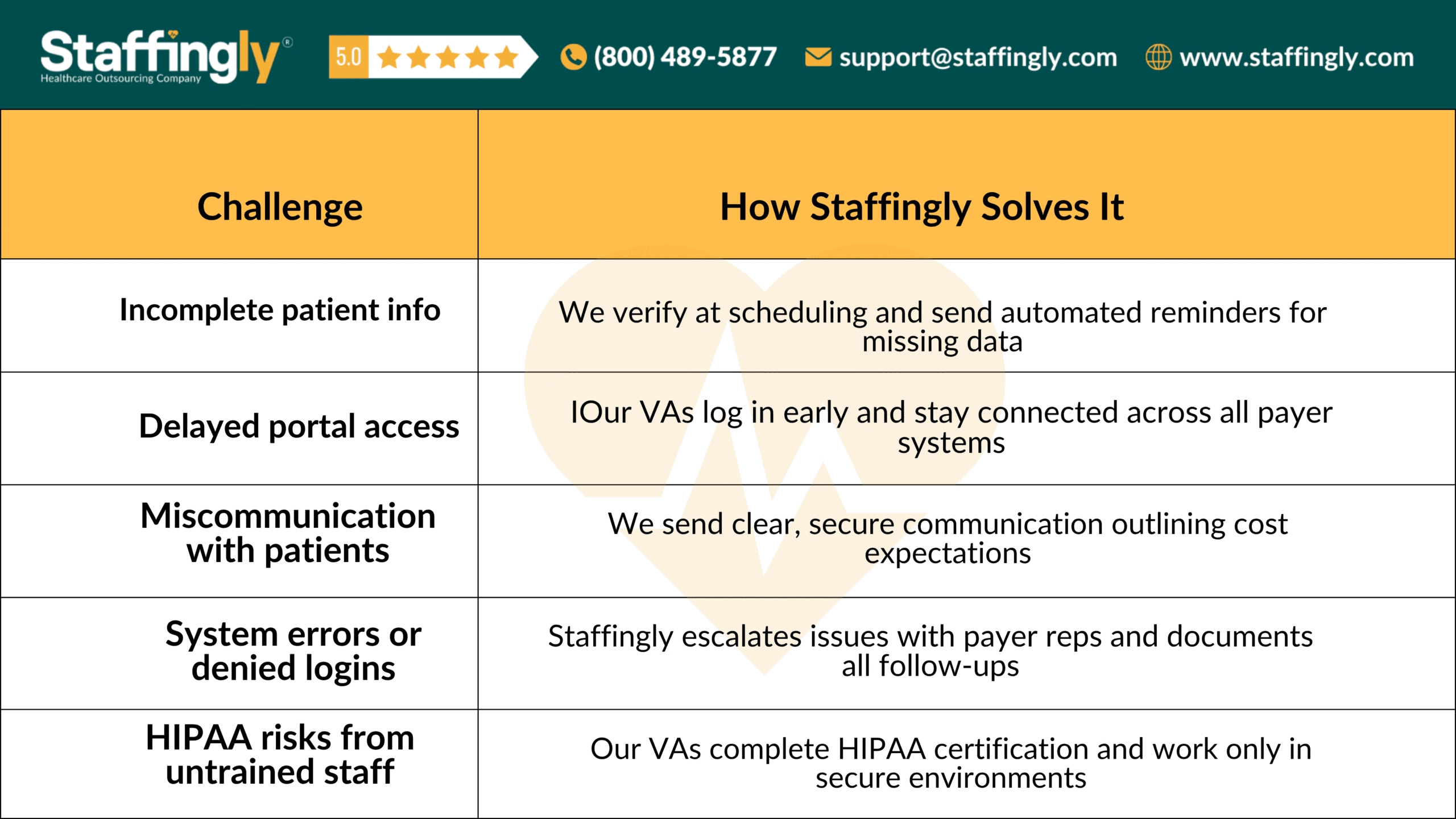On-Demand Outsourcing BPO Services for Healthcare Providers With 24/7 Coverage!
Save up to 70% on staffing costs!
Browse Specialty Staffing ServicesIs Your Insurance Verification Workflow Both Efficient and HIPAA Protected?

At 8:02 AM, the first patient arrived for a follow-up visit—but there was a problem. Her new insurance card hadn’t been updated, and no one had verified her benefits. The front desk scrambled to call the payer. Meanwhile, the provider waited. The patient grew frustrated. And the visit started 20 minutes late.
This wasn’t a one-off. It was happening every day.
Insurance verification is critical—but when it’s slow or inaccurate, it can derail your entire clinic. Worse? If done improperly, it can expose protected health information (PHI) and put your practice at risk of HIPAA violations.
Why Insurance Verification Matters More Than Ever?
Insurance verification sits at the center of your revenue cycle. Without it:
-
Claims get denied
-
Appointments are delayed
-
Patients are confused about their costs
-
Staff wastes time chasing down missing data
But there’s more to it than speed. Every insurance lookup, call, portal login, and data entry involves PHI. That means your workflow must be airtight in both efficiency and privacy protection.
Staffingly’s insurance verification virtual assistants solve both. We verify coverage fast—without ever compromising security.
How Insurance Verification Works (When Done Right)?
At its core, insurance verification includes five essential steps:
-
Collect Patient Info
Gather updated insurance card, member ID, DOB, and visit type. -
Check Coverage Status
Log into payer portals (e.g., Availity, UHC, Medicare) or call payers to confirm eligibility for the date of service. -
Review Plan Details
Confirm active status, copay, coinsurance, deductibles, and benefit limitations (e.g., visit caps or referrals). -
Update the EHR
Document all verified data in the patient’s chart, including verification reference numbers and call logs. -
Communicate with Patient
Let patients know what to expect: their financial responsibility, any issues, or next steps before they arrive.
Done manually, this process is slow, error-prone, and risky. Done by a trained HIPAA-compliant virtual assistant, it’s fast, secure, and accurate.
What Gets Verified in a Protected Workflow?
A comprehensive insurance verification should include:
-
Plan active status
-
Type of plan (PPO, HMO, Medicare, Medicaid, etc.)
-
In-network vs. out-of-network status
-
Deductibles and out-of-pocket balances
-
Copays and coinsurance amounts
-
Authorization/referral requirements
-
Service limitations or exclusions
-
Coordination of benefits or secondary insurance
At Staffingly, our virtual assistants verify each of these data points in a way that’s logged, encrypted, and protected—every time.
When Verification Should Happen (Timing Matters)?
Timing isn’t just about convenience—it’s about claims getting paid. Staffingly ensures verification is completed:
-
48–72 hours before appointments (for routine visits)
-
Same day for walk-ins or urgent visits
-
Immediately after scheduling for new patients
-
At the start of each month for patients in long-term treatment (to catch policy changes)
-
Before high-cost services or diagnostics to avoid uncovered costs
We also track expiring authorizations and coverage lapses, flagging them proactively so your billing team isn’t caught off guard.
The Role of Technology in HIPAA-Protected Verification
Technology makes insurance verification faster—but only if it’s used securely. Staffingly’s tools include:
-
Portal logins via VPN and MFA (multi-factor authentication)
-
EHR-integrated eligibility checks (Athena, eCW, Kareo, etc.)
-
Encrypted ticketing and call logging tools
-
Password-protected access to payer systems
-
Real-time data updates stored in HIPAA-compliant systems
No spreadsheets, no sticky notes, no screenshots. Just structured, secure, and auditable workflows.
Common Challenges in Insurance Verification
Staffingly’s Role in Insurance Verification
When you outsource verification to Staffingly, you get:
-
Trained virtual medical assistants specialized in insurance workflows
-
Real-time portal verification using tools like Availity, NaviNet, and payer portals
-
HIPAA-compliant data handling with encryption, VPNs, and audit trails
-
Seamless documentation into your existing EHR
-
Reduced front desk workload so your in-office team can focus on patients
-
Fewer denials and faster reimbursements
Our team doesn’t just verify—they protect, track, and document every step.
What Did We Learn?
Insurance verification isn’t just a checkmark—it’s the foundation of every clean claim, every smooth visit, and every satisfied patient.
But if your workflow isn’t fast and HIPAA secure, you’re at risk for delays, denials, and data breaches.
Staffingly gives you the best of both: highly efficient, fully compliant insurance verification support. With our team behind your front desk, you stay on schedule, protect PHI, and get paid faster.
What People Are Asking?
Q: How long does insurance verification take?
A: It usually takes 15–30 minutes per patient, depending on the payer. Staffingly handles this in advance so your team doesn’t fall behind.
Q: Can we trust a virtual assistant with PHI?
A: Yes—if they’re HIPAA trained and working on secure systems. Staffingly’s VAs use encrypted devices, VPN access, and strict documentation protocols.
Q: What happens if insurance changes after scheduling?
A: We reverify coverage before the visit and alert your team if anything changes—no surprises for you or the patient.
Q: Do you support all insurances?
A: Yes. Our team is trained across all major commercial plans, Medicare, Medicaid, and managed care organizations.
Q: Is this service only for large clinics?
Disclaimer
For informational purposes only; not applicable to specific situations.
For tailored support and professional services,
Please contact Staffingly, Inc. at (800) 489-5877
Email : support@staffingly.com.
About This Blog : This Blog is brought to you by Staffingly, Inc., a trusted name in healthcare outsourcing. The team of skilled healthcare specialists and content creators is dedicated to improving the quality and efficiency of healthcare services. The team passionate about sharing knowledge through insightful articles, blogs, and other educational resources.
 Book a Demo to Build Your Team Today!
Book a Demo to Build Your Team Today!


 Read Case Studies
Read Case Studies 


 Virtual Medical Assistants
Virtual Medical Assistants



